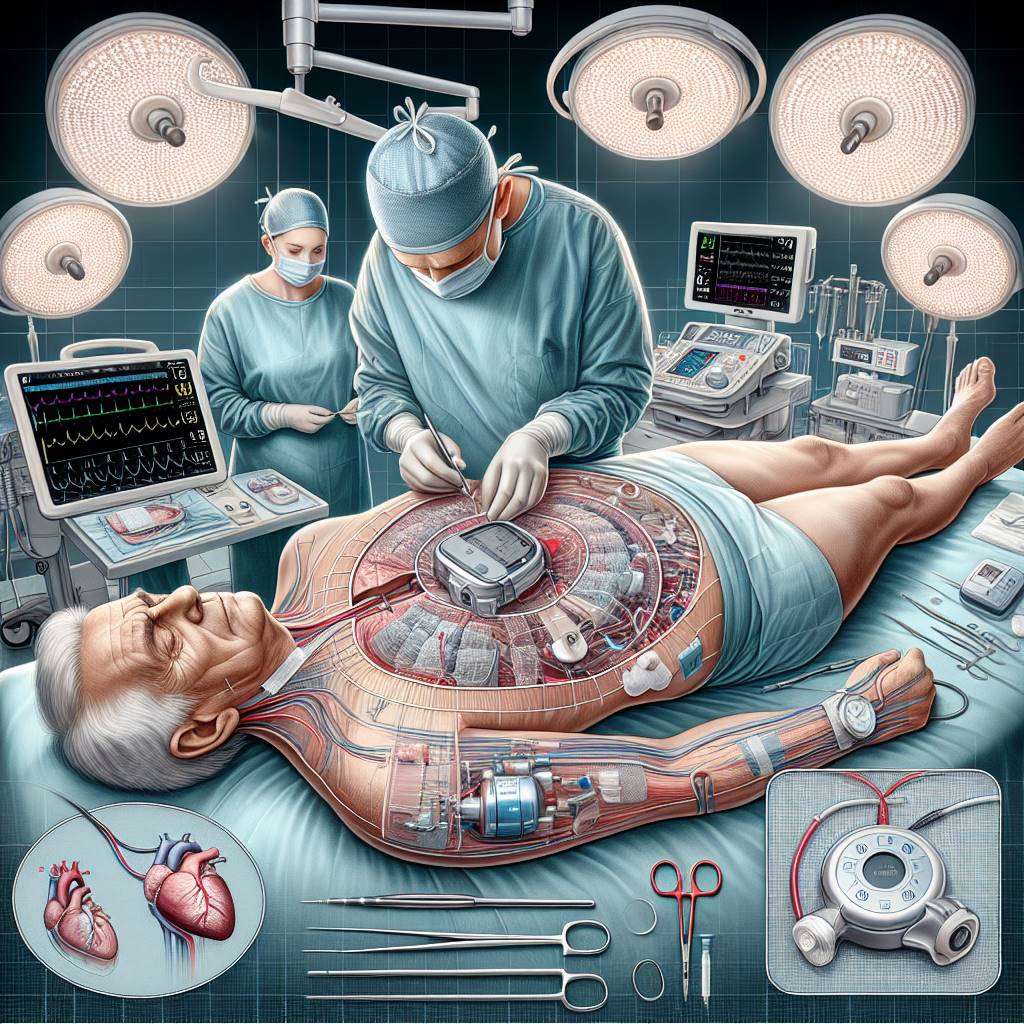A pacemaker implantation is a life-saving procedure designed to regulate abnormal heart rhythms, also known as arrhythmias. This minimally invasive surgery ensures that the heart beats at a normal rate, improving blood flow and overall health. Understanding the process can help patients feel more confident and prepared for the procedure.
Knowing what to expect during a pacemaker surgery is crucial for both patients and caregivers. From preparation to recovery, each step is carefully planned to ensure safety and effectiveness. This guide provides a detailed overview of the procedure, helping patients make informed decisions about their cardiac health.
Understanding the Purpose of a Pacemaker Implantation
A pacemaker is a small medical device implanted under the skin to help manage irregular heartbeats. It sends electrical impulses to the heart to maintain a steady rhythm, especially in patients with bradycardia (slow heart rate) or other types of arrhythmias. This device is essential for individuals whose hearts cannot regulate their rhythm naturally.
The primary goal of a pacemaker is to improve the quality of life by reducing symptoms such as fatigue, dizziness, and fainting caused by an irregular heartbeat. It also prevents complications like heart failure or stroke. By ensuring a consistent heart rate, a pacemaker allows patients to lead a more active and healthy lifestyle.

Who Needs a Pacemaker and Why?
A pacemaker is recommended for individuals with specific heart conditions that affect the heart's electrical system. Common conditions include bradycardia, where the heart beats too slowly, or heart block, where electrical signals are delayed or blocked entirely. These issues can lead to symptoms like fatigue, shortness of breath, or even loss of consciousness.
Patients with certain types of arrhythmias, such as atrial fibrillation, may also benefit from a pacemaker. Additionally, those recovering from heart surgery or experiencing complications from medications may require this device. A cardiologist will evaluate the patient's condition through tests like an ECG or Holter monitor to determine if a pacemaker is necessary.
Preparing for Your Pacemaker Implantation Procedure
Proper preparation is essential for a successful pacemaker implantation. Before the procedure, your doctor will conduct a thorough evaluation, including blood tests, imaging studies, and an electrocardiogram (ECG). These tests help assess your heart's condition and ensure you are fit for surgery.
Patients are typically advised to avoid eating or drinking for several hours before the procedure. Medications that affect blood clotting, such as blood thinners, may need to be temporarily stopped. Your healthcare provider will give you specific instructions to follow in the days leading up to the surgery.
- Discuss any allergies or medical conditions with your doctor.
- Arrange for someone to drive you home after the procedure.
- Wear loose, comfortable clothing on the day of surgery.
What Happens Before Pacemaker Surgery?
Before the pacemaker surgery, you will be admitted to the hospital and prepped for the procedure. A nurse will check your vital signs, including blood pressure and heart rate. You may also receive an intravenous (IV) line for administering medications during the surgery.
The surgical site, usually near the collarbone, will be cleaned and shaved to reduce the risk of infection. You will be given a local anesthetic to numb the area, ensuring minimal discomfort during the procedure. In some cases, a mild sedative may be administered to help you relax.
Step-by-Step Guide to Pacemaker Implantation Process
The pacemaker implantation procedure typically takes one to two hours and involves several key steps. Here is a general overview of the process:
- A small incision is made near the collarbone.
- Leads (thin wires) are guided through a vein into the heart.
- The leads are connected to the pacemaker device.
- The pacemaker is placed under the skin, and the incision is closed.
After the surgery, the device is tested to ensure it is functioning correctly. You will be monitored in a recovery area for a few hours before being discharged. Your doctor will provide detailed instructions on post-surgery care and follow-up appointments to check the pacemaker's performance.
How Long Does Pacemaker Surgery Take?
The duration of a pacemaker implantation procedure typically ranges from 1 to 2 hours. However, the exact time may vary depending on the complexity of the case and the patient’s overall health condition. The surgery is usually performed under local anesthesia, which means you’ll be awake but won’t feel pain in the area being operated on.
During the procedure, the surgeon carefully inserts the pacemaker device and connects it to your heart using thin wires called leads. This process requires precision and expertise to ensure the device functions properly. After the implantation, the pacemaker is tested to confirm it is working as intended.
It’s important to note that while the surgery itself is relatively quick, you may need to stay in the hospital for a few hours or overnight for observation. This ensures that there are no immediate complications and that the device is functioning optimally.

What to Expect During Pacemaker Placement
Pacemaker placement is a straightforward procedure, but understanding the steps can help ease any anxiety. Before the surgery, you’ll undergo a thorough evaluation, including blood tests and imaging, to ensure you’re fit for the procedure. The surgery is typically performed in a sterile operating room or catheterization lab.
Here’s what happens during the procedure:
- A small incision is made near the collarbone.
- Leads (thin wires) are inserted into a vein and guided to the heart using X-ray imaging.
- The pacemaker device is placed under the skin and connected to the leads.
- The device is tested to ensure it’s functioning correctly before the incision is closed.
After the surgery, you’ll be monitored for a few hours to ensure there are no immediate complications. Most patients can return home the same day or the next, depending on their recovery.
Types of Pacemakers and Their Implantation Methods
There are several types of pacemakers, each designed to address specific heart rhythm disorders. The most common types include:
- Single-chamber pacemaker: Connects to one chamber of the heart, usually the right atrium or ventricle.
- Dual-chamber pacemaker: Connects to both the right atrium and ventricle, helping coordinate their activity.
- Biventricular pacemaker: Used for patients with heart failure, it stimulates both ventricles to improve heart function.
The implantation method depends on the type of pacemaker. For example, traditional pacemakers are implanted under the skin near the collarbone, while leadless pacemakers are placed directly inside the heart via a catheter. Your doctor will recommend the most suitable option based on your condition.
Understanding the different types and their functions can help you make an informed decision about your treatment.
Is Pacemaker Implantation Painful? What to Know
One of the most common concerns among patients is whether pacemaker surgery is painful. The good news is that the procedure is generally well-tolerated. Local anesthesia is used to numb the area, so you won’t feel pain during the surgery. You may, however, feel some pressure or mild discomfort as the device is implanted.
After the procedure, it’s normal to experience some soreness or bruising around the incision site. This discomfort is usually mild and can be managed with over-the-counter pain relievers, as advised by your doctor. Most patients report that the pain subsides within a few days.
If you experience severe pain, swelling, or signs of infection, such as redness or fever, contact your healthcare provider immediately. These could indicate complications that need prompt attention.
Risks and Safety Measures During Pacemaker Surgery
While pacemaker implantation is generally safe, like any surgical procedure, it carries some risks. Potential complications include infection at the incision site, bleeding, or damage to blood vessels or the heart. Rarely, the leads may dislodge, requiring repositioning.
To minimize these risks, surgeons follow strict safety protocols. These include using sterile equipment, carefully monitoring the patient during the procedure, and conducting thorough pre-surgical evaluations. Patients are also advised to follow post-operative care instructions to reduce the risk of complications.
Here’s a quick comparison of common risks and their likelihood:
| Risk |
Likelihood |
| Infection |
Low |
| Bleeding |
Moderate |
| Lead displacement |
Rare |
By choosing an experienced surgeon and adhering to medical advice, you can significantly reduce the likelihood of complications and ensure a smooth recovery.
Recovery Timeline After Pacemaker Implantation
After a pacemaker implantation, recovery typically progresses in stages. In the first 24–48 hours, patients may experience mild discomfort or swelling at the incision site. It's important to rest and avoid strenuous activities during this period.
Within the first week, most patients can resume light activities, but heavy lifting and vigorous exercise should be avoided for at least 4–6 weeks. The healing process varies, but by the end of the first month, many individuals feel fully recovered and can return to their normal routines.
Regular follow-ups with your cardiologist are crucial to monitor the pacemaker's functionality and ensure proper healing. Always adhere to your doctor’s advice for a smooth recovery.

Post-Surgery Care Tips for Pacemaker Patients
Proper care after pacemaker surgery is essential for a successful recovery. Keep the incision site clean and dry to prevent infection. Avoid applying creams or lotions unless prescribed by your doctor.
Refrain from lifting your arm on the side of the implantation above shoulder level for at least 4–6 weeks. This helps prevent dislodging the pacemaker leads. Additionally, avoid heavy lifting or strenuous activities during this period.
- Follow your doctor’s instructions regarding medications.
- Attend all scheduled follow-up appointments.
- Report any unusual symptoms like swelling, redness, or fever immediately.
By following these post-surgery care tips, you can ensure a smooth recovery and reduce the risk of complications.
When to Contact Your Doctor After Pacemaker Surgery
Knowing when to contact your doctor after pacemaker implantation is vital. Seek immediate medical attention if you experience symptoms such as severe chest pain, shortness of breath, or dizziness. These could indicate a serious issue with the pacemaker or your heart.
Other warning signs include persistent swelling, redness, or discharge at the incision site, which may signal an infection. If you notice irregular heartbeats or feel that the pacemaker is not functioning properly, consult your doctor promptly.
Regular communication with your healthcare provider ensures that any potential complications are addressed early, ensuring the pacemaker's effectiveness and your overall health.
Common Questions About Pacemaker Implantation Answered
Many patients have concerns about pacemaker implantation. One common question is, "Will I feel the pacemaker working?" Most people do not feel it, but some may notice slight sensations during adjustments.
Another frequent query is about lifestyle changes. While you can resume most activities, avoid prolonged exposure to strong electromagnetic fields, as they may interfere with the pacemaker. Devices like MRI machines or certain industrial equipment should be used with caution.
Patients also ask about the lifespan of a pacemaker. Typically, the battery lasts 5–15 years, depending on usage. Your doctor will monitor its performance during follow-ups.
Life After Pacemaker: What Changes to Expect
Life after a pacemaker implantation often improves significantly, as the device helps regulate your heart rhythm. However, some adjustments are necessary. For example, you may need to avoid certain electronic devices or magnets that can interfere with the pacemaker.
Most patients can return to their normal activities, including work and light exercise, within a few weeks. However, activities like contact sports should be avoided to prevent damage to the device.
Regular check-ups are essential to ensure the pacemaker is functioning correctly. With proper care and lifestyle adjustments, you can lead a healthy, active life with a pacemaker.
Best Pacemaker Surgery Doctors in India
Dr. Balbir Singh, a renowned cardiologist at Medanta - The Medicity, Gurugram, has over 30 years of experience in electrophysiology and pacemaker implantation. Another expert is Dr. Praveen Chandra from Fortis Escorts Heart Institute, Delhi, with DM in Cardiology and extensive international exposure in advanced cardiac procedures. Both are recognized for their medical excellence and patient care.
Learn more on best pacemaker implantation surgery doctors in india
Best Pacemaker Surgery Hospitals in India
Leading hospitals for pacemaker implantation include Fortis Escorts Heart Institute, Delhi, known for its multidisciplinary cardiac care, and Medanta - The Medicity, Gurugram, offering robotic-assisted cardiac procedures. Both are NABH and JCI accredited, providing international patient services and high success rates in cardiac treatments.
Find more best pacemaker implantation surgery hospitals in india
Pacemaker Surgery Cost in India
The cost of pacemaker implantation in India typically ranges from INR 2,50,000 to INR 5,00,000 (approximately USD 3,000 to USD 6,000). Factors influencing costs include the type of pacemaker, hospital category, and doctor’s expertise. The average hospital stay is 2-3 days. India offers a significant cost advantage compared to Western countries, with options for insurance coverage and third-party financing.
Learn pacemaker implantation surgery cost in india
Pacemaker Surgery Treatment in India
Pacemaker implantation in India involves local anesthesia, insertion of the pacemaker device under the skin, and connection to the heart via leads. Advanced technologies like 3D mapping and minimally invasive techniques are commonly used. Recovery typically takes 1-2 weeks. Top hospitals in India adhere to global medical protocols and leverage innovations to ensure patient safety and successful outcomes.
Learn on Pacemaker Surgery Treatment in India
FAQs
What is a pacemaker, and why is it needed?
A pacemaker is a small device implanted in the chest to regulate abnormal heart rhythms. It is needed for conditions like bradycardia or heart block, where the heart beats too slowly or irregularly.
How long does a pacemaker implantation procedure take?
The procedure typically takes 1-2 hours, depending on the complexity and the type of pacemaker being implanted.
Is pacemaker implantation a major surgery?
No, pacemaker implantation is considered a minimally invasive procedure. It is performed under local anesthesia with a short recovery period.
What precautions should I take after pacemaker implantation?
Avoid heavy lifting, strenuous activities, and direct pressure on the implantation site for a few weeks. Regular follow-ups are essential to monitor the device.
How long does a pacemaker last?
A pacemaker typically lasts 5-15 years, depending on the type and usage. Regular check-ups ensure its proper functioning.
Can I travel with a pacemaker?
Yes, you can travel with a pacemaker. However, inform airport security about the device, as it may trigger metal detectors. Carry your pacemaker ID card at all times.
Are there any risks associated with pacemaker implantation?
Risks are minimal but may include infection, bleeding, or lead displacement. Choosing an experienced doctor reduces these risks significantly.
Can I use electronic devices with a pacemaker?
Most electronic devices are safe to use. However, avoid prolonged exposure to strong electromagnetic fields, as they may interfere with the pacemaker.
What follow-up care is required after pacemaker implantation?
Regular follow-ups are necessary to check the pacemaker's battery life and ensure it is functioning correctly. Adjustments may be made if needed.
Is pacemaker implantation covered by insurance in India?
Yes, most health insurance policies in India cover pacemaker implantation. Check with your provider for specific coverage details.
Understanding Cardiac Devices: Pacemakers and Defibrillators
When it comes to managing heart conditions, pacemakers and defibrillators play crucial roles. While both devices help regulate heart rhythms, they serve different purposes. For a detailed comparison of these two essential devices, check out our blog on Pacemaker vs. Defibrillator (ICD): Key Differences Explained, which outlines their functionalities and when each is used.
As technology advances, the safety of these devices in various medical procedures becomes a significant concern. One common question is about the compatibility of modern pacemakers with MRI scans. To learn more about this topic, read our informative article on How MRI-Safe Are Modern Pacemakers? What You Need to Know, which discusses the latest developments in MRI safety for patients with pacemakers.
Understanding the differences and safety measures associated with these devices is vital for patients and healthcare providers alike.